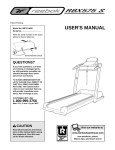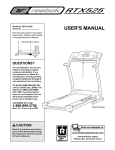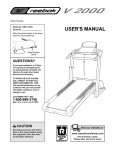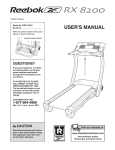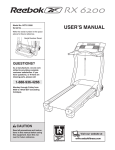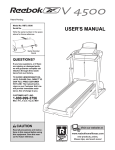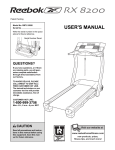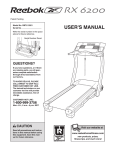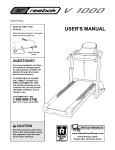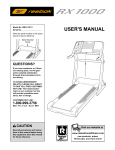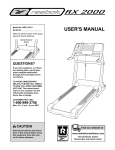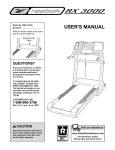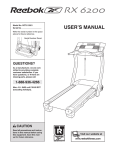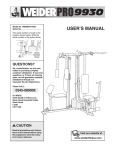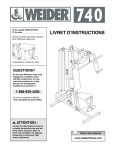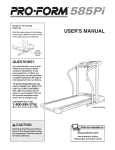Download Reebok Fitness RBTL14500 User's Manual
Transcript
® ® Patent Pending Model No. RBTL14500 Serial No. USER'S MANUAL Write the serial number in the space above for future reference. Serial Number Decal QUESTIONS? As a manufacturer, we are committed to providing complete customer satisfaction. If you have questions, or if there are missing or damaged parts, we will guarantee complete satisfaction through direct assistance from our factory. TO AVOID UNNECESSARY DELAYS, PLEASE CALL DIRECT TO OUR TOLL-FREE CUSTOMER HOT LINE. The trained technicians on our Customer Hot Line will provide immediate assistance, free of charge to you. CUSTOMER HOT LINE: 1-800-999-3756 Mon.–Fri., 6 a.m.–6 p.m. MST CAUTION Read all precautions and instructions in this manual before using this equipment. Save this manual for future reference. Visit our website at www.workoutwarehouse.com ® ® new products, prizes, fitness tips, and much more! TABLE OF CONTENTS IMPORTANT PRECAUTIONS . . . . . . . . . . . . . . . . . . . . . . . . . . . . . . . . . . . . . . . . . . . . . . . . . . . . . . . . . . . . . . . . .2 BEFORE YOU BEGIN . . . . . . . . . . . . . . . . . . . . . . . . . . . . . . . . . . . . . . . . . . . . . . . . . . . . . . . . . . . . . . . . . . . . . . .4 ASSEMBLY . . . . . . . . . . . . . . . . . . . . . . . . . . . . . . . . . . . . . . . . . . . . . . . . . . . . . . . . . . . . . . . . . . . . . . . . . . . . . . .5 HOW TO USE THE HEART RATE MONITOR . . . . . . . . . . . . . . . . . . . . . . . . . . . . . . . . . . . . . . . . . . . . . . . . . . . .6 TREADMILL OPERATION . . . . . . . . . . . . . . . . . . . . . . . . . . . . . . . . . . . . . . . . . . . . . . . . . . . . . . . . . . . . . . . . . . . .7 HOW TO FOLD AND MOVE THE TREADMILL . . . . . . . . . . . . . . . . . . . . . . . . . . . . . . . . . . . . . . . . . . . . . . . . . .24 TROUBLE-SHOOTING . . . . . . . . . . . . . . . . . . . . . . . . . . . . . . . . . . . . . . . . . . . . . . . . . . . . . . . . . . . . . . . . . . . . .26 REEBOK UNIVERSITY . . . . . . . . . . . . . . . . . . . . . . . . . . . . . . . . . . . . . . . . . . . . . . . . . . . . . . . . . . . . . . . . . . . . .29 EXERCISE GUIDELINES . . . . . . . . . . . . . . . . . . . . . . . . . . . . . . . . . . . . . . . . . . . . . . . . . . . . . . . . . . . . . . . . . . .31 PART LIST . . . . . . . . . . . . . . . . . . . . . . . . . . . . . . . . . . . . . . . . . . . . . . . . . . . . . . . . . . . . . . . . . . . . . . . . . . . . . . .34 HOW TO ORDER REPLACEMENT PARTS . . . . . . . . . . . . . . . . . . . . . . . . . . . . . . . . . . . . . . . . . . . . . . . . . . . . .35 LIMITED WARRANTY . . . . . . . . . . . . . . . . . . . . . . . . . . . . . . . . . . . . . . . . . . . . . . . . . . . . . . . . . . . . . . .Back Cover Note: An EXPLODED DRAWING is attached in the center of this manual. IMPORTANT PRECAUTIONS WARNING: To reduce the risk of burns, fire, electric shock, or injury to persons, read the following important precautions and information before operating the treadmill. 1. It is the responsibility of the owner to ensure that all users of this treadmill are adequately informed of all warnings and precautions. wearing only stockings, or in sandals. 10. When connecting the power cord (see page 7), plug the power cord into a surge suppressor (not included) and plug the surge suppressor into a grounded circuit capable of carrying 15 or more amps. No other appliance should be on the same circuit. 2. Use the treadmill only as described. 3. Place the treadmill on a level surface, with eight feet of clearance behind it. Do not place the treadmill on any surface that blocks air openings. To protect the floor or carpet from damage, place a mat under the treadmill. 11. Use only a single-outlet surge suppressor that is UL 1449 listed as a transient voltage surge suppressor (TVSS). The surge suppressor must have a UL suppressed voltage rating of 400 volts or less and a minimum surge dissipation of 450 joules. The surge suppressor must be electrically rated for 120 volts AC and 15 amps. 4. Keep the treadmill indoors, away from moisture and dust. Do not put the treadmill in a garage or covered patio, or near water. 5. Do not operate the treadmill where aerosol products are used or where oxygen is being administered. 12. Keep the power cord and the surge suppressor away from heated surfaces. 6. Keep children under the age of 12 and pets away from the treadmill at all times. 13. Never move the walking belt while the power is turned off. Do not operate the treadmill if the power cord or plug is damaged, or if the treadmill is not working properly. (See BEFORE YOU BEGIN on page 4 if the treadmill is not working properly.) 7. The treadmill should not be used by persons weighing more than 300 pounds. 8. Never allow more than one person on the treadmill at a time. 14. Never start the treadmill while you are standing on the walking belt. Always hold the handrails while using the treadmill. 9. Wear appropriate exercise clothing when using the treadmill. Do not wear loose clothing that could become caught in the treadmill. Athletic support clothes are recommended for both men and women. Always wear athletic shoes. Never use the treadmill with bare feet, 15. The treadmill is capable of high speeds. Adjust the speed in small increments to avoid sudden jumps in speed. 2 16. The heart rate monitor is not a medical device. Various factors, including the user's movement, may affect the accuracy of heart rate readings. The heart rate monitor is intended only as an exercise aid in determining heart rate trends in general. tion of the on/off switch.) 21. Do not attempt to raise, lower, or move the treadmill until it is properly assembled. (See ASSEMBLY on page 5, and HOW TO MOVE THE TREADMILL on page 24.) You must be able to safely lift 45 pounds (20 kg) in order to raise, lower, or move the treadmill. 17. When using iFIT.com CD’s and videos, an electronic “chirping” sound will alert you when the speed and/or incline of the treadmill is about to change. Always listen for the “chirp” and be prepared for speed and/or incline changes. In some instances, the speed and/or incline may change before the personal trainer describes the change. 22. When folding or moving the treadmill, make sure that the storage latch is fully closed. 23. Inspect and tighten all parts of the treadmill every three months. 24. Never drop or insert any object into any opening. 18. When using iFIT.com CD’s and videos, you can manually override the speed and incline settings at any time by pressing the speed and incline buttons. However, when the next “chirp” is heard, the speed and/or incline will change to the next settings of the CD or video program. 25. DANGER: Always unplug the power cord immediately after use, before cleaning the treadmill, and before performing the maintenance and adjustment procedures described in this manual. Never remove the motor hood unless instructed to do so by an authorized service representative. Servicing other than the procedures in this manual should be performed by an authorized service representative only. 19. Always remove iFIT.com CD’s and videos from your CD player or VCR when you are not using them. 20. Never leave the treadmill unattended while it is running. Always remove the key, unplug the power cord and move the on/off switch to the off position when the treadmill is not in use. (See the drawing on page 4 for the loca- 26. This treadmill is intended for in-home use only. Do not use this treadmill in any commercial, rental, or institutional setting. WARNING: Before beginning this or any exercise program, consult your physician. This is especially important for persons over the age of 35 or persons with pre-existing health problems. Read all instructions before using. ICON assumes no responsibility for personal injury or property damage sustained by or through the use of this product. SAVE THESE INSTRUCTIONS The decals shown have been placed on the treadmill. If a decal is missing, or if it is not legible, please call our Customer Service Department, toll-free, to order a free replacement decal (see HOW TO ORDER REPLACEMENT PARTS on page 35 of this manual). Apply the decal in the location shown. Note: The decal below is shown at 38% of actual size. 3 BEFORE YOU BEGIN Thank you for selecting the REEBOK® RBX 545s treadmill. The RBX 545s treadmill combines advanced technology with innovative design to let you enjoy an effective form of cardiovascular exercise in the convenience and privacy of your home. And when you’re not exercising, the unique RBX 545s can be folded up, requiring less than half the floor space of other treadmills. at 1-800-999-3756, Monday through Friday, 6 a.m. until 6 p.m. Mountain Time (excluding holidays). To help us assist you, please note the product model number and serial number before calling. The model number of the treadmill is RBTL14500. The serial number can be found on a decal attached to the treadmill (see the front cover of this manual for the location). For your benefit, read this manual carefully before using the treadmill. If you have additional questions, please call our Customer Service Department toll-free Before reading further, please familiarize yourself with the parts that are labeled in the drawing below. Console Reading Rack Water Bottle Holder (Bottle not included) Handrail Upright Key/Clip Lock Knob On/Off Switch Circuit Breaker Walking Belt Foot Rail Power Cord Rear Roller Adjustment Bolt 4 ASSEMBLY Assembly requires two people. Set the treadmill in a cleared area and remove all packing materials. Do not dispose of the packing materials until assembly is completed. A rubber mallet may be needed for assembly. Note: The underside of the treadmill walking belt is coated with high-performance lubricant. During shipping, a small amount of lubricant may be transferred to the top of the walking belt or the shipping carton. This is a normal condition and does not affect treadmill performance. If there is lubricant on top of the walking belt, simply wipe off the lubricant with a soft cloth and a mild, non-abrasive cleaner. 1. With the help of a second person, carefully raise the Uprights (65) until the treadmill is in the position shown. 1 65 2. Press the Lock Knob Sleeve (68) into the left Upright (65). If necessary, use a rubber mallet to tap the Lock Knob Sleeve into the Upright. Remove the Lock Knob (67) from the Lock Pin (72). Make sure that the Lock Pin Collar (70) and the Spring (69) are on the Lock Pin. (Note: If there are two Lock Pin Collars, place them on each side of the Spring.) Insert the Lock Pin into the left Upright (65) and tighten the Lock Knob onto the Lock Pin. 2 65 69 67 68 70 72 3. Make sure that all parts are tightened before you use the treadmill. Keep the included allen wrench in a secure place. The allen wrench is used to adjust the walking belt (see pages 26 and 27). To protect the floor or carpet from damage, place a mat under the treadmill. 5 HOW TO USE THE HEART RATE MONITOR HOW TO PUT ON THE HEART RATE MONITOR use, it may remain activated longer than necessary, draining the battery prematurely. The heart rate monitor consists of two components: the chest strap and the sensor unit (see the drawing below). Insert the tab on one end of the chest strap through the hole in one end of the sensor unit. Press the end of the sensor unit under the buckle on the chest strap. The tab should be almost flush with the front of the sensor unit. • Store the heart rate monitor in a warm, dry place. Do not store the heart rate monitor in a plastic bag or other container that may trap moisture. • Do not expose the heart rate monitor to direct sunlight for extended periods of time; do not expose it to temperatures above 122° Fahrenheit (50° Celsius) or below 14° Fahrenheit (-10° Celsius). • Do not excessively bend or stretch the sensor unit when using or storing the heart rate monitor. Chest Strap Tabs • Clean the sensor unit using a damp cloth—never use alcohol, abrasives, or chemicals. The chest strap may be hand washed and air dried. Buckle HEART RATE MONITOR TROUBLE-SHOOTING Sensor Unit The instructions on the following pages explain how the heart rate monitor is used with the console. If the heart rate monitor does not function properly, try the steps below. Tab Next, wrap the heart rate monitor around your chest and attach the other end of the chest strap to the sensor unit. Adjust the length of the chest strap, if necessary. The heart rate monitor should be under your clothing, tight against your skin, and as high under the pectoral muscles or breasts as is comfortable. Make sure that the logo on the sensor unit is facing forward and is right-side-up. • Make sure that the heart rate monitor is under your clothing, tight against your skin, and as high under the pectoral muscles or breasts as is comfortable. The logo on the sensor unit must be facing forward and be right-side-up. Note: If the heart rate monitor does not function when positioned as described, try moving it slightly lower or higher on your chest. • Use saline solution such as saliva or contact lens solution to wet the two electrode areas on the sensor unit. If heart rate readings do not appear until you begin perspiring, re-wet the electrode areas. • As you walk or run on the treadmill, position yourself near the center of the walking belt. For the console to display heart rate readings, the user must be within arm’s length of the console. Pull the sensor unit away from your body a few inches and locate the two electrode areas on the inner side. The electrode areas are the areas covered by shallow ridges. Using saline solution such as saliva or contact lens solution, wet both electrode areas. Return the sensor unit to a position against your chest. • The heart rate monitor is designed to work with people who have normal heart rhythms. Heart rate reading problems may be caused by medical conditions such as premature ventricular contractions (pvcs), tachycardia bursts, and arrhythmia. HEART RATE MONITOR CARE AND MAINTENANCE • The operation of the heart rate monitor can be affected by magnetic interference caused by high power lines or other sources. If it is suspected that this is a problem, try relocating the treadmill. • Thoroughly dry the heart rate monitor after each use. The heart rate monitor is activated when the electrode areas are wetted and the heart rate monitor is put on; the heart rate monitor shuts off when it is removed and the electrode areas are dried. If the heart rate monitor is not dried after each • The CR2032 battery may need to be replaced (see page 28). 6 TREADMILL OPERATION THE PERFORMANT LUBETM WALKING BELT This product is for use on a nominal 120-volt circuit, and has a grounding plug that looks like the plug illustrated in drawing 1 below. A temporary adapter that looks like the adapter illustrated in drawing 2 may be used to connect the surge suppressor to a 2-pole receptacle as shown in drawing 2 if a properly grounded outlet is not available. Your treadmill features a walking belt coated with PERFORMANT LUBETM, a high-performance lubricant. IMPORTANT: Never apply silicone spray or other substances to the walking belt or the walking platform. Such substances will deteriorate the walking belt and cause excessive wear. 1 HOW TO PLUG IN THE POWER CORD Grounded Outlet Box Surge Suppressor DANGER: Improper connection Grounding Pin of the equipment-grounding conductor can result in an increased risk of electric shock. Check with a qualified electrician or serviceman if you are in doubt as to whether the product is properly grounded. Do not modify the plug provided with the product—if it will not fit the outlet, have a proper outlet installed by a qualified electrician. Grounding Pin Grounded Outlet Grounding Plug 2 Grounded Outlet Box Adapter Your treadmill, like any other type of sophisticated electronic equipment, can be seriously damaged by sudden voltage changes in your home’s power. Voltage surges, spikes, and noise interference can result from weather conditions or from other appliances being turned on or off. To decrease the possibility of your treadmill being damaged, always use a surge suppressor with your treadmill (see drawing 1 at the right). Surge Suppressor Lug Metal Screw Use only a single-outlet surge suppressor that is UL 1449 listed as a transient voltage surge suppressor (TVSS). The surge suppressor must have a UL suppressed voltage rating of 400 volts or less and a minimum surge dissipation of 450 joules. The surge suppressor must be electrically rated for 120 volts AC and 15 amps. The temporary adapter should be used only until a properly grounded outlet (drawing 1) can be installed by a qualified electrician. The green-colored rigid ear, lug, or the like extending from the adapter must be connected to a permanent ground such as a properly grounded outlet box cover. Whenever the adapter is used it must be held in place by a metal screw. Some 2-pole receptacle outlet box covers are not grounded. Contact a qualified electrician to determine if the outlet box cover is grounded before using an adapter. This product must be grounded. If it should malfunction or break down, grounding provides a path of least resistance for electric current to reduce the risk of electric shock. This product is equipped with a cord having an equipment-grounding conductor and a grounding plug. Plug the power cord into a surge suppressor, and plug the surge suppressor into an appropriate outlet that is properly installed and grounded in accordance with all local codes and ordinances. Important: The treadmill is not compatible with GFCI-equipped outlets. 7 H N O A F G F B C J I E K E F D L Note: If there is a thin sheet of clear plastic on the face of the console, remove it. M FEATURES OF THE CONSOLE special iFIT.com CD programs (CD’s are available separately). IFIT.com CD programs automatically control the speed and incline of the treadmill as a personal trainer guides you through every step of your workout. High-energy music provides added motivation. Each CD features two programs designed by certified personal trainers. The advanced console offers an impressive array of features to make your workouts more effective. When the console is in the manual mode, the speed and incline of the treadmill can be changed with a touch of a button. As you exercise, the LED displays will provide continuous exercise feedback. In addition, you can connect the treadmill to your VCR and TV and play iFIT.com video programs (videocassettes are available separately). Video programs offer the same benefits as iFIT.com CD programs, but add the excitement of working out with a class and an instructor—the hottest new trend at health clubs. The console also offers ten preset workout programs— four fat burn programs that automatically control the speed and incline of the treadmill to give you effective fat-burning workouts; four aerobic programs that control the speed and incline of the treadmill to provide optimal aerobic exercise; and two pulse programs that change the speed and incline to keep your heart rate within a target range during your workouts. With the treadmill connected to your computer, you can also go to our new internet site at www.iFIT.com and access basic programs, audio programs, and video programs directly from the internet. And by adding an optional iFIT.com module to the treadmill, you can use virtually endless features from our internet site. See www.iFIT.com for complete details. You can even create your own custom workout programs and store them in memory for future use. The console also features new iFIT.com interactive technology. IFIT.com technology is like having a personal trainer right in your home. Using the included audio cable, you can connect the treadmill to your home stereo, portable stereo, or computer and play To purchase iFIT.com CD’s or videocassettes or an optional iFIT.com module, call toll-free 1-800-7350768. 8 DIAGRAM OF THE CONSOLE H. LED Matrix—When the manual mode is selected, the matrix will show your progress on an LED track. When a workout program is selected, the matrix will show the upcoming speed settings or target heart rate settings of the program. Refer to the drawing on page 8. A. ENTER Button—This button is used to enter age, weight, and maximum heart rate settings. I. MODE Button—This button is used to select the manual mode, workout programs, and the iFit.com mode. B. + and – Buttons—These buttons are used to change age, weight, and maximum heart rate settings. C. USER Button—This button is used to select user information. Up to three different users can store age, weight, and maximum heart rate settings. J. START Button—This button starts the walking belt. K. LEARN Button—This button is used to program speed and incline settings for custom programs. D. QUICK SPEED Buttons—These buttons allow you to quickly select speed settings from 1 mph to 10 mph. L. STOP Button—This button stops the walking belt. When the button is pressed, the LED displays will pause and the TIME display will flash. E. SPEED Buttons—These buttons control the speed of the walking belt. Each time a button is pressed, the speed will change by 0.1 mph; if a button is held down, the speed will change in increments of 0.5 mph. The speed range is 0.5 mph to 12 mph. M. Key with Clip—The key turns the console on and off. The attached clip is designed to be worn on your waistband. If the key is pulled from the console, the power will automatically turn off. F. LED Displays—These displays provide continuous feedback of the calories and fat calories you have burned, the speed of the walking belt, your current pace, the distance you have walked or run, the number of laps you have completed, and the elapsed time. In addition, the PULSE display shows your heart rate when the heart rate monitor is worn. Note: The console can display speed and distance in either miles or kilometers (see page 12). For simplicity, all instructions in this manual refer to miles. N. INCLINE Buttons—These buttons control the incline of the treadmill. Each time a button is pressed, the incline will change by 0.5%. The incline range is 1.5% to 10%. O. INCLINE Display—This display shows the incline level of the treadmill. The first indicator will light when the incline is at 1.5%, the second indicator will light when the incline is at 2% or 2.5%, the third indicator will light when the incline is at 3% or 3.5%, and so forth. G. Manual/Program Indicators—These indicators show when the manual mode, a workout program, or the iFit.com mode is selected. 9 HOW TO ENTER USER INFORMATION CAUTION: Before operating the console, read the following precautions. Each time the power is turned on, the USER 1 indicator will begin to flash. The console allows up to three different users to enter their weight, their age, and a maximum heart rate setting into the console. • Do not stand on the walking belt when turning on the power or starting the walking belt. • Always wear the clip (see M on page 8) while operating the treadmill. If the key is pulled from the console, the walking belt will stop. • The treadmill is capable of high speeds; adjust the speed in small increments. If you enter your weight into the console, the CALS/ FAT CALS display will be more accurate. If you want to use a pulse program, you must enter your age and a maximum heart rate setting. • To reduce the risk of electric shock, keep the console dry. Avoid spilling liquid on the console and use only a sealable water bottle. If you want to enter your weight, your age, or a maximum heart rate setting, follow the instructions below. 1 HOW TO TURN ON THE POWER Make sure that the on/off switch, located on the front of the treadmill, is in the on position. Press the USER button. Press the USER button to designate yourself as user 1. The USER 1 indicator will remain lit without flashing. Note: To designate yourself as user 2 or user 3, press the USER button repeatedly. IMPORTANT: Each time you use the treadmill, make sure that the correct user is selected. On Next, make sure that the power cord is properly plugged in (see page 7). 2 Enter your weight if desired. The current weight setting will be shown in the CALS/FAT CALS display. Press the + or – button to enter your weight. Each button press will change the weight setting by 1 pound; if a button is held down, the weight setting will change in increments of 5 pounds. When your weight is shown, press the ENTER button. Note: Once your weight is entered, it will be saved in memory, even when the power cord is unplugged. Stand on the foot rails of the treadmill. Find the clip attached to the key (see the drawing on page 9), and slide the clip onto the waistband of your clothes. Next, insert the key fully into the console. After a moment, various displays and indicators will light. Test the clip by carefully taking a few steps backward until the key is pulled from the console. If the key is not pulled from the console, reposition the clip on your waistband as needed. Then reinsert the key fully into the console. To use the manual mode of the console, follow the steps beginning on page 11. To use a fat burn program or an aerobic program, see page 13. To use a pulse program, see page 14. To create and use a custom program, see pages 16 and 17. To use an iFIT.com CD or video program, refer to page 20. To use an iFIT.com program directly from our internet site, see page 22. 10 3 Enter your age if desired. HOW TO USE THE MANUAL MODE The current age setting will be shown in the PULSE display. Press the + or – button to enter your age. Each button press will change the age setting by 1 year; if a button is held down, the age setting will change in increments of 5 years. When your age is shown, press the ENTER button. Note: Once your age is entered, it will be saved in memory, even when the power cord is unplugged. 4 1 Insert the key into the console. See HOW TO TURN ON THE POWER on page 10. 2 Select user 1, 2, or 3. When the key is inserted, user 1 will be selected, as shown by the USER 1 indicator. If you have designated yourself as user 2 or 3, press the USER button repeatedly until the appropriate indicator lights. Enter a maximum heart rate setting if desired. The current maximum heart rate setting will be shown in the LED matrix. When a pulse program is used, this is the highest level that your heart rate will reach during the program. This setting is a percentage of your estimated maximum heart rate. (Your estimated maximum heart rate is 220 minus your age. For example, if you are 30 years old, your estimated maximum heart rate is 190.) 3 Enter your weight if desired. If you have not entered your weight, see HOW TO ENTER USER INFORMATION on page 10. 4 Select the manual mode. When the key is inserted, the manual mode will be selected. If you have selected a workout program or the iFIT.com mode, you can select the manual mode again by pressing the MODE button repeatedly until the manual indicator lights. If desired, you can change the maximum heart rate setting by pressing the + and – buttons. Each button press will change the setting by 1%; if a button is held down, the setting will change in increments of 5%. The setting can be from 65% to 85%. When the desired setting is shown, press the ENTER button. Note: When the key is removed from the console, the maximum heart rate setting will be reset to 65%. 5 Press the START button or the SPEED + button to start the walking belt. A moment after the button is pressed, the walking belt will begin to move at 1.0 mph. Hold the handrails and begin walking. As you exercise, change the speed of the walking belt as desired by pressing the SPEED buttons or the QUICK SPEED buttons. CAUTION: Change the speed in small increments to avoid sudden jumps in speed. To stop the walking belt, press the STOP button. The displays will pause and the TIME display will begin to flash. To restart the walking belt, press the START button or the SPEED + button. Note: When either of the SPEED buttons is pressed, the SPEED/PACE display will show the selected speed setting for seven seconds. The display will then show the actual speed of the walking belt. 11 6 How to select miles per hour or kilometers per hour: Speed can be displayed in either miles per hour (mph) or kilometers per hour (kph). To change the unit of measurement, first hold down the STOP button while inserting the key into the console. The SPEED/PACE display will show either an “E” for English miles or an “M” for metric kilometers. Press the SPEED + button to change the unit of measurement. Then, remove and reinsert the key. Adjust the incline as desired. To vary the intensity of your workout, change the incline of the treadmill as desired by pressing the INCLINE buttons Note: After the INCLINE buttons are pressed, it will take a moment for the treadmill to reach the selected incline setting. 7 Follow your progress with the LED track and the LED displays. DISTANCE/LAPS display—This display shows the distance that the walking belt has moved and the number of laps you have completed (one lap equals 1/4 mile). The display will alternate between one number and the other every seven seconds. The LED Track—The LED track represents a distance of 1/4 mile. As you exercise, the indicators around the track will light one at a time until you have completed 1/4 mile. A new lap will then begin. Note: If the speed is displayed in miles per hour, the distance will be displayed in miles; if the speed is displayed in kilometers per hour, the distance will be displayed in kilometers. CALS/FAT CALS display—This display shows the approximate numbers of calories and fat calories you have burned (see FAT BURNING on page 29). Every seven seconds, the display will change from one number to the other. TIME display—This display shows the total time that the walking belt has been moving. Note: When a workout program is selected, this display will show the time remaining in the program. PULSE display—This display shows your heart rate when the heart rate monitor is worn. 8 When you are finished exercising, stop the walking belt and remove the key. Step onto the foot rails, press the STOP button, and change the incline of the treadmill to the lowest setting. The incline must be at the lowest setting when the treadmill is folded to the storage position or the treadmill will be damaged. SPEED/PACE display— This display shows the speed of the walking belt and your current pace (pace is measured in minutes per mile). The display will alternate between one number and the other every seven seconds. Note: When either of the SPEED buttons is pressed, the display will show the speed setting. Next, remove the key from the console and put it in a secure place. Finally, move the on/off switch to the off position and unplug the power cord. 12 matrix.) The speed settings for the next twelve periods will be shown in the twelve columns to the right. HOW TO USE FAT BURN PROGRAMS AND AEROBIC PROGRAMS The four fat burn programs and the four aerobic programs automatically control the speed and incline of the treadmill as they guide you through effective workouts. Follow the steps below to use a fat burn program or an aerobic program. 1 When only three seconds remain in the first period of the program, both the CURRENT PERIOD column and the column to the right will flash, a series of tones will sound, and all speed settings will move one column to the left. The speed setting for the second period will then be shown in the flashing CURRENT PERIOD column and the treadmill will automatically adjust to the speed and incline settings for the second period. Insert the key into the console. See HOW TO TURN ON THE POWER on page 10. 2 Select user 1, 2, or 3. See step 2 on page 11. 3 The program will continue in this way until the speed setting for the last period is shown in the CURRENT PERIOD column and the TIME display counts down to zero. The walking belt will then slow to a stop. Enter your weight if desired. If you have not entered your weight, see HOW TO ENTER USER INFORMATION on page 10. 4 Select the desired program. Note: Each time a period ends and the speed settings move to the left, if all of the indicators in the CURRENT PERIOD column are lit, the speed settings may move downward so that only the highest indicators in the columns will appear in the LED matrix. When the speed settings move to the left again and not all of the indicators in the CURRENT PERIOD column are lit, the speed settings will move back up. When the key is inserted, the manual mode will be selected. To select a fat burn program or an aerobic program, press the MODE button repeatedly until one of the four fat burn indicators or one of the four aerobic indicators lights. The LED matrix will show the first twelve speed settings of the program you have selected. The SPEED/PACE display will flash the program’s maximum speed setting and the INCLINE display will flash the program’s maximum incline setting for ten seconds. 5 CURRENT PERIOD If the speed or incline setting for the current period is too high or too low, you can manually override the setting by pressing the SPEED or INCLINE buttons. Every few times one of the SPEED buttons is pressed, an additional indicator will light or darken in the CURRENT PERIOD column. If any of the columns to the right of the CURRENT PERIOD column have the same number of lit indicators as the CURRENT PERIOD column, an additional indicator may light or darken in those columns as well. Note: If you manually adjust the speed setting so that all of the indicators in the CURRENT PERIOD column are lit, the speed settings in the LED matrix will not move downward as described above. Note: If you manually override the speed or incline setting for the current period, when the period ends the treadmill will automatically adjust to the speed and incline settings for the next period. Press the START button or the SPEED + button to start the program. A moment after the button is pressed, the treadmill will automatically adjust to the first speed and incline settings for the program. Hold the handrails and begin walking. Each program is divided into several time periods of different lengths. One speed setting and one incline setting are programmed for each period. The speed setting for the first period is shown in the flashing CURRENT PERIOD column of the LED matrix. (The incline settings are not shown in the 13 To stop the program temporarily, press the STOP button. The TIME display will begin to flash. To restart the program, press the START button or the SPEED + button. To end the program, press the STOP button, remove the key, and then reinsert the key. 6 Follow your progress with the LED displays. Pulse programs 1 and 2 automatically control the speed and incline of the treadmill to keep your heart rate within a preset range during your workouts. Follow the instructions below to use pulse programs 1 or 2. See step 7 on page 12. 7 HOW TO USE PULSE PROGRAMS 1 When the program is completed, remove the key. Insert the key into the console. See HOW TO TURN ON THE POWER on page 10. Make sure that the incline of the treadmill is at the lowest setting. The incline must be at the lowest setting when the treadmill is folded to the storage position or the treadmill will be damaged. 2 Select user 1, 2, or 3. See step 2 on page 11. 3 Next, remove the key from the console and put it in a secure place. In addition, move the on/off switch to the off position and unplug the power cord. Enter your weight, your age, and a maximum heart rate setting. If you enter your weight into the console, the CALS/FAT CALS display will be more accurate. To use pulse programs 1 or 2, you must enter your age and a maximum heart rate setting. If you have not entered this information, see HOW TO ENTER USER INFORMATION on page 10. 4 Put on the heart rate monitor. The heart rate monitor must be worn when a pulse program is used. (See HOW TO USE THE HEART RATE MONITOR on page 6.) Note: A pulse program can be started without a heart rate reading; however, the speed and/or incline of the treadmill will automatically decrease if your heart rate is not detected during the program. 5 Select the desired program. When the key is inserted, the manual mode will be selected. To select pulse program 1 or 2, press the MODE button repeatedly until the pulse program 1 or 2 indicator lights. The first thirteen target heart rate settings of the program you have selected will appear in the LED matrix. 14 6 If your heart rate is not detected during the program, the letters “PLS” will flash in the PULSE display and the speed and/or incline of the treadmill will automatically decrease. (See HEART RATE MONITOR TROUBLE-SHOOTING on page 6.) Press the START button or the SPEED + button to start the program. A moment after the button is pressed, the treadmill will automatically adjust to the first speed and incline settings for the program. Hold the handrails and begin walking. While the program is in progress, minor adjustments can be made to the speed or incline of the treadmill with the SPEED or INCLINE buttons. However, if you increase the speed, the incline will automatically decrease; if you decrease the speed, the incline will increase. If you increase the incline, the speed will decrease; if you decrease the incline, the speed will increase. The console will always attempt to keep your heart rate near the heart rate setting shown in the CURRENT PERIOD column. Note: When the incline reaches the lowest setting, the speed cannot be increased any further. When the incline reaches the highest setting, the speed cannot be decreased any further. Pulse proCURRENT PERIOD grams 1 and 2 consist of twenty-three, one-minute periods. One target heart rate setting is programmed for each period. The target heart rate setting for the first period will be shown in the flashing CURRENT PERIOD column of the LED matrix. The target heart rate settings for the next twelve periods will be shown in the twelve columns to the right. To stop the program, press the STOP button. Pulse programs should not be stopped temporarily and then restarted. To use the pulse program again, reselect the program and start it at the beginning. When only three seconds remain in the first period of the program, both the CURRENT PERIOD column and the column to the right will flash and a series of tones will sound. All target heart rate settings will then move one column to the left. The target heart rate setting for the second period will then be shown in the CURRENT PERIOD column. 7 Follow your progress with the LED displays. See step 7 on page 12. 8 As the program progresses, the speed and/or incline of the treadmill will change automatically to keep your heart rate near the heart rate setting shown in the CURRENT PERIOD column. The program will continue until the heart rate setting for the last period is shown in the CURRENT PERIOD column and the TIME display counts down to zero. The walking belt will then slow to a stop. When the program is completed, remove the key. See step 7 on page 14. 15 the first period CURRENT PERIOD is shown in the flashing CURRENT PERIOD column of the LED matrix. (The incline settings are not shown in the matrix.) To program speed and incline settings for the first period, simply adjust the speed and incline of the treadmill to the desired levels with the SPEED and INCLINE buttons. Every few times the SPEED buttons are pressed, one additional indicator will light or darken in the CURRENT PERIOD column. HOW TO CREATE CUSTOM PROGRAMS Custom programs 1 and 2 are workout programs that you create. The programs control both the speed and incline of the treadmill and can be up to 40 minutes long. The programs are stored in memory and can be changed as many times as desired. Follow the steps below to create a custom program. 1 Insert the key into the console. See HOW TO TURN ON THE POWER on page 10. 2 Select user 1, 2, or 3. See step 2 on page 11. 3 When the first one-minute period of the program is completed, a series of tones will sound and the current speed and incline settings will be stored in memory. All speed settings shown in the LED matrix will then move one column to the left and the speed setting for the second period will be shown in the flashing CURRENT PERIOD column. Program speed and incline settings for the second period as described above. Repeat this procedure until you have programmed speed and incline settings for as many periods as desired. Programs can have up to forty periods. Enter your weight if desired. If you have not entered your weight, see HOW TO ENTER USER INFORMATION on page 10. 4 Select custom program 1 or 2. When the key is inserted, the manual mode will be selected. To select a custom program, press the MODE button repeatedly until the custom 1 or 2 indicator lights. 5 Note: To stop the program for a moment, press the STOP button. The displays will pause and the TIME display will begin to flash. To restart the program, press the START or SPEED + button. Press the START button or the SPEED + button to start the program. 7 A moment after the button is pressed, the walking belt will begin to move. Hold the handrails and begin walking. 6 Press the STOP button, remove the key, and then reinsert the key. When you have programmed speed and incline settings for as many one-minute periods as desired, press the STOP button, remove the key, and then reinsert the key. The speed and incline settings that you have programmed and the length of the program will be stored in memory. To use the program again, see HOW TO USE CUSTOM PROGRAMS on page 17. Press the LEARN button and program the desired speed and incline settings. When the LEARN button is pressed, the LEARN indictor will light. Speed and incline settings can be programmed only when the indicator is lit. 8 Each program is divided into one-minute periods. One speed setting and one incline setting can be programmed for each period. The speed setting for 16 When the program is completed, remove the key. See step 7 on page 14. When only three seconds remain in the first period of the program, both the CURRENT PERIOD column and the column to the right will flash and a series of tones will sound. All speed settings will then move one column to the left. The speed setting for the second period will then be shown in the CURRENT PERIOD column and the speed and incline of the treadmill will adjust to the second settings that you programmed previously. HOW TO USE CUSTOM PROGRAMS 1 Insert the key into the console. See HOW TO TURN ON THE POWER on page 10. 2 Select user 1, 2, or 3. The program will continue in this way until the speed setting for the last period is shown in the CURRENT PERIOD column and the TIME display counts down to zero. The walking belt will then slow to a stop. See step 2 on page 11. 3 Enter your weight if desired. If you have not entered your weight, see HOW TO ENTER USER INFORMATION on page 10. 4 During the program, the speed and incline settings for the current period can be adjusted with the SPEED and INCLINE buttons. Adjustments will not be stored in memory. To reprogram speed and incline settings, press the LEARN button. The LEARN indicator will light. Speed and incline settings can be reprogrammed only when the indicator is lit. Next, adjust the speed and incline of the treadmill with the SPEED and INCLINE buttons. When the current period of the program is completed, the new speed and incline settings will be stored in memory. When you have reprogrammed speed and incline settings for as many periods as desired, press the LEARN button again. Select custom program 1 or 2. When the key is inserted, the manual mode will be selected. To select a custom program, press the MODE button repeatedly until the custom 1 or 2 indicator lights. 5 Press the START button or the SPEED + button to start the program. A moment after the button is pressed, the walking belt will begin to move. Hold the handrails and begin walking. To stop the program temporarily, press the STOP button. The TIME display will begin to flash. To restart the program, press the START button or the SPEED + button. To end the program, press the STOP button, remove the key, and then reinsert the key. Each custom program is divided into one-minute periods. One speed setting and one incline setting are programmed for each period. The speed setting for the first period is CURRENT PERIOD shown in the flashing CURRENT PERIOD column of the LED matrix. (The incline settings are not shown in the matrix.) 6 Follow your progress with the LED displays. Refer to step 7 on page 12. 7 When the program is completed, remove the key. See step 7 on page 14. 17 HOW TO CONNECT THE TREADMILL TO YOUR CD PLAYER, VCR, OR COMPUTER To use iFIT.com CD’s, the treadmill must be connected to your portable CD player, portable stereo, home stereo, or computer with CD player. See pages 18 and 19 for connecting instructions. To use iFIT.com videocassettes, the treadmill must be connected to your VCR. See page 20 for connecting instructions. To use iFIT.com programs directly from our internet site, the treadmill must be connected to your home computer. See page 19 for connecting instructions. HOW TO CONNECT YOUR PORTABLE STEREO Note: If your stereo has an RCA-type AUDIO OUT jack, see instruction A below. If your stereo has a 3.5mm LINE OUT jack, see instruction B. If your stereo has only a PHONES jack, see instruction C. A. Plug one end of the audio cable into the jack on the front of the treadmill near the power cord. Plug the other end of the cable into the included adapter. Plug the adapter into an AUDIO OUT jack on your stereo. A HOW TO CONNECT YOUR PORTABLE CD PLAYER AUDIO OUT RIGHT Note: If your CD player has separate LINE OUT and PHONES jacks, see instruction A below. If your CD player has only one jack, see instruction B. A. Plug one end of the audio cable into the jack on the front of the treadmill near the power cord. Plug the other end of the cable into the LINE OUT jack on your CD player. Plug your headphones into the PHONES jack. A PHONES LINE OUT LINE OUT LEFT Audio Cable Adapter B. Plug one end of the audio cable into the jack on the front of the treadmill near the power cord. Plug the other end of the cable into the LINE OUT jack on your stereo. PHONES B Headphones Audio Cable LINE OUT Audio Cable B. Plug one end of the audio cable into the jack on the front of the treadmill near the power cord. Plug the other end of the cable into a 3.5mm Y-adapter (available at electronics stores). Plug the Y-adapter into the PHONES jack on your CD player. Plug your headphones into the other side of the Y-adapter. B C. Plug one end of the audio cable into the jack on the front of the treadmill near the power cord. Plug the other end of the cable into a 3.5mm Y-adapter (available at electronics stores). Plug the Y-adapter into the PHONES jack on your stereo. Plug your headphones into the other side of the Y-adapter. PHONES C PHONES Audio Cable 3.5mm Y-adapter PHONES Audio Cable Headphones 3.5mm Y-adapter Headphones 18 HOW TO CONNECT YOUR HOME STEREO HOW TO CONNECT YOUR COMPUTER Note: If your stereo has an unused LINE OUT jack, see instruction A below. If the LINE OUT jack is being used, see instruction B. Note: If your computer has a 3.5mm LINE OUT jack, see instruction A. If your computer has only a PHONES jack, see instruction B. A. Plug one end of the audio cable into the jack on the front of the treadmill near the power cord. Plug the other end of the cable into the included adapter. Plug the adapter into the LINE OUT jack on your stereo. A. Plug one end of the audio cable into the jack on the front of the treadmill near the power cord. Plug the other end of the cable into the LINE OUT jack on your computer. A A CD LINE OUT VCR Amp LINE OUT Audio Cable LINE OUT Audio Cable Adapter B. Plug one end of the audio cable into the jack on the front of the treadmill near the power cord. Plug the other end of the cable into a 3.5mm Y-adapter (available at electronics stores). Plug the Y-adapter into the PHONES jack on your computer. Plug your headphones or speakers into the other side of the Y-adapter. B. Plug one end of the audio cable into the jack on the front of the treadmill near the power cord. Plug the other end of the cable into the included adapter. Plug the adapter into an RCA Y-adapter (available at electronics stores). Next, remove the wire that is currently plugged into the LINE OUT jack on your stereo and plug the wire into the unused side of the RCA Y-adapter. Plug the RCA Y-adapter into the LINE OUT jack on your stereo. B B PHONES CD Audio Cable VCR Amp 3.5mm Y-adapter LINE OUT Headphones/Speakers Audio Cable RCA Y-adapter Adapter Wire removed from LINE OUT jack 19 HOW TO CONNECT YOUR VCR HOW TO USE IFIT.COM CD AND VIDEO PROGRAMS Note: If your VCR has an unused AUDIO OUT jack, see instruction A below. If the AUDIO OUT jack is being used, see instruction B. If you have a TV with a built-in VCR, see instruction B. If your VCR is connected to your home stereo, see HOW TO CONNECT YOUR HOME STEREO on page 19. To use iFIT.com CD’s or videocassettes, the treadmill must be connected to your portable CD player, portable stereo, home stereo, computer with CD player, or VCR. See HOW TO CONNECT THE TREADMILL TO YOUR CD PLAYER, VCR, OR COMPUTER on page 18. Note: To purchase iFIT.com CD’s or videocassettes, call toll-free 1-800-735-0768. Follow the steps below to use an iFIT.com CD or video program. A. Plug one end of the audio cable into the jack on the front of the treadmill near the power cord. Plug the other end of the cable into the included adapter. Plug the adapter into the AUDIO OUT jack on your VCR. 1 A Insert the key into the console. See HOW TO TURN ON THE POWER on page 10. ANT. IN VIDEO AUDIO IN RF OUT CH 3 4 OUT 2 AUDIO OUT RIGHT LEFT Audio Cable Select user 1, 2, or 3. See step 2 on page 11. Adapter 3 Select the iFIT.com mode. When the key is inserted, the manual mode will be selected. To use an iFIT.com CD or video program, press the MODE button repeatedly until the iFIT.com indicator lights. The letters “I FIT” and one moving indicator will appear in the LED matrix. B. Plug one end of the audio cable into the jack on the front of the treadmill near the power cord. Plug the other end of the cable into the included adapter. Plug the adapter into an RCA adapter (available at electronics stores). Next, remove the wire that is currently plugged into the AUDIO OUT jack on your VCR and plug the wire into the unused side of the RCA adapter. Plug the RCA adapter into the AUDIO OUT jack on your VCR. 4 Insert the iFIT.com CD or videocassette. If you are using an iFIT.com CD, insert the CD into your CD player. If you are using an iFIT.com videocassette, insert the videocassette into your VCR. B ANT. IN VIDEO AUDIO IN RF OUT CH 3 4 5 OUT A moment after the button is pressed, your personal trainer will begin guiding you through your workout. Simply follow your personal trainer’s instructions. Note: If the TIME display is flashing, press the START button or the SPEED + button on the console. The treadmill will not respond to a CD or video program when the TIME display is flashing. RCA Adapter Audio Cable Press the PLAY button on your CD player or VCR. Adapter Wire removed from AUDIO OUT jack During the CD or video program, an electronic “chirping” sound will alert you when the speed and/or incline of the treadmill is about to change. CAUTION: Always listen for the “chirp” and be prepared for speed and/or incline changes. In some instances, the speed and/or incline may change before the personal trainer describes the change. 20 If the speed or incline settings are too high or too low, you can manually override the settings at any time by pressing the SPEED or INCLINE buttons on the console. However, when the next “chirp” is heard, the speed and/or incline will change to the next settings of the CD or video program. • adjust the volume of your CD player or VCR. If the volume is too high or too low, the console may not detect the program signals. • make sure that the audio cable is properly connected, that it is fully plugged in, and that it is not wrapped around a power cord. To stop the walking belt at any time, press the STOP button on the console. The TIME display will begin to flash. To restart the program, press the START button or the SPEED + button. After a moment, the walking belt will begin to move at 1.0 mph. When the next “chirp” is heard, the speed and incline will change to the next settings of the CD or video program. The program can also be stopped by pressing the stop button on your CD player or VCR. • if you are using your portable CD player and the CD skips, set the CD player on the floor or another flat surface instead of on the console. 6 Follow your progress with the LED displays. See step 7 on page 12. 7 When the CD or video program is completed, the walking belt will stop and the TIME display will begin to flash. Note: To use another CD or video program, press the STOP button or remove the key and go to step 1 on page 20. When the program is completed, remove the key. See step 7 on page 14. CAUTION: Always remove iFIT.com CD’s and videocassettes from your CD player or VCR when you are finished using them. Note: If the speed or incline of the treadmill does not change when a “chirp” is heard: • make sure that the iFIT.com indicator is lit and that the TIME display is not flashing. If the TIME display is flashing, press the START button or the SPEED + button on the console. 21 7 HOW TO USE PROGRAMS DIRECTLY FROM OUR INTERNET SITE When you start the program, an on-screen countdown will begin. Our new internet site at www.iFIT.com allows you to access a selection of programs that interactively control your treadmill to help you achieve your specific exercise goals. In addition, you can play iFIT.com audio and video programs directly from the internet. By adding an optional iFIT.com module to the console, you can use virtually endless features from our internet site. Explore www.iFIT.com for details. To purchase an optional iFIT.com module, call toll-free 1-800-884-0620. 8 If the speed or incline settings are too high or too low, you can manually override the settings at any time by pressing the SPEED or INCLINE buttons on the console. However, when the next “chirp” is heard, the speed and/or incline will change to the next settings of the program. Insert the key into the console. See HOW TO TURN ON THE POWER on page 10. 2 To stop the walking belt at any time, press the STOP button on the console. The TIME display will begin to flash. To restart the program, press the START button or the SPEED + button. After a moment, the walking belt will begin to move at 1.0 mph. When the next “chirp” is heard, the speed and incline will change to the next settings of the program. Select user 1, 2, or 3. See step 2 on page 11. 3 Select the iFIT.com mode. When the key is inserted, the manual mode will be selected. To use an iFIT.com CD or video program, press the MODE button repeatedly until the iFIT.com indicator lights. The letters “I FIT” and one moving indicator will appear in the LED matrix. 4 Go to your computer and start an internet connection. 5 Start your web browser, if necessary, and go to our internet site at www.iFIT.com. 6 Follow the desired links on our internet site to select a program. Return to the treadmill and stand on the foot rails. Find the clip attached to the key and slide the key onto the waistband of your clothing. When the on-screen countdown ends, the program will begin and the walking belt will begin to move. Hold the handrails, step onto the walking belt, and begin walking. During the program, an electronic “chirping” sound will alert you when the speed and/or incline of the treadmill is about to change. CAUTION: Always listen for the “chirp” and be prepared for speed and/or incline changes. To use programs from our internet site, the treadmill must be connected to your home computer. See HOW TO CONNECT YOUR COMPUTER on page 19. In addition, you must have an internet connection and an internet service provider. A list of specific system requirements will be found on our internet site. Follow the steps below to use a program from our internet site. 1 Follow the on-line instructions to start the program. When the program is completed, the walking belt will stop and the TIME display will begin to flash. Note: To use another program, press the STOP button and go to step 6. Note: If the speed or incline of the treadmill does not change when a “chirp” is heard, make sure that the iFIT.com indicator is lit and that the TIME display is not flashing. In addition, make sure that the audio cable is properly connected, that it is fully plugged in, and that it is not wrapped around a power cord. 9 Follow your progress with the LED displays. See step 7 on page 12. Read and follow the on-line instructions for using a program. 10 When the program is completed, remove the key. See step 7 on page 14. 22 THE INFORMATION MODE/DEMO MODE THE OPTIONAL IFIT.COM MODULE The console features an information mode that keeps track of the total number of hours that the treadmill has been operated and the total number of miles that the walking belt has moved. The information mode also allows you to switch the console from miles per hour to kilometers per hour. In addition, the information mode allows you to turn on and turn off the demo mode. By adding the optional iFIT.com module to the treadmill, you can use virtually endless features from our internet site. Imagine on-line competitions, personal training sessions via the internet, and enabling your computer to track your workouts. For information about purchasing the optional iFIT.com module, call toll-free 1-800-884-0620. To select the information mode, hold down the STOP button while inserting the key into the console. When the information mode is selected, the following information will be shown: The SPEED/PACE display will show an “E” (for English miles) or an “M” (for metric kilometers). The unit of measurement can be changed by pressing the SPEED + button. The DISTANCE/LAPS display will show the total number of miles that the walking belt has moved. The TIME display will show the total number of hours that the treadmill has been used. IMPORTANT: Make sure that there is not a letter “d” in the CALS/FAT CALS display. If a “d” appears in the display, the console is in the “demo” mode. This mode is intended to be used only when a treadmill is displayed in a store. When the console is in the demo mode, the power cord can be plugged in, the key can be removed from the console, and the displays and indicators on the console will automatically light in a preset sequence, although the buttons on the console will not operate. If a “d” appears in the CALS/FAT CALS display when the information mode is selected, press the SPEED – button so the display is blank. To exit the information mode, remove the key from the console. 23 HOW TO FOLD AND MOVE THE TREADMILL HOW TO FOLD THE TREADMILL FOR STORAGE 1 Before folding the treadmill, adjust the incline to the lowest position. If this is not done, the treadmill may be permanently damaged. Next, unplug the power cord. CAUTION: You must be able to safely lift 45 pounds (20 kg) in order to raise, lower, or move the treadmill. 1. Hold the treadmill with your hands in the locations shown at the right. CAUTION: To decrease the possibility of injury, bend your legs and keep your back straight. As you raise the treadmill, make sure to lift with your legs rather than your back. Raise the treadmill about halfway to the vertical position. 2. Move your right hand to the position shown and hold the treadmill firmly. Hold the lock knob with your left hand and pull it to the side. Raise the treadmill until the lock knob is aligned with the catch. Slowly release the lock knob. Make sure that the pin on the lock knob is inside of the catch. To protect the floor or carpet from damage, place a mat under the treadmill. Keep the treadmill out of direct sunlight. Do not leave the treadmill in the storage position in temperatures above 85° Fahrenheit. 2 Lock Knob Pin Catch HOW TO MOVE THE TREADMILL Before moving the treadmill, convert the treadmill to the storage position as described above. Make sure that the pin on the lock knob is inside of the catch. Book Holder 1. Hold the handrails as shown and place one foot against the hood only in the location shown. Do not hold or push on the book holder or it may be damaged. 2. Tilt the treadmill back until it rolls freely on the front wheels. Carefully move the treadmill to the desired location. Never move the treadmill without tipping it back. To reduce the risk of injury, use extreme caution while moving the treadmill. Do not move the treadmill over an uneven surface. 3. Place one foot on the base and carefully lower the treadmill until it is resting on the base. 24 Base Front Wheels HOW TO LOWER THE TREADMILL FOR USE 1. Hold the upper end of the treadmill with your right hand as shown. Hold the lock knob with your left hand and pull it to the side. Pivot the treadmill down a few inches. 1 Lock Knob Catch 2. Hold the treadmill firmly with both hands and lower the treadmill to the floor. Do not drop the treadmill frame to the floor. To decrease the possibility of injury, bend your legs and keep your back straight. 25 2 Pin TROUBLE-SHOOTING Most treadmill problems can be solved by following the steps below. Find the symptom that applies, and follow the steps listed. If further assistance is needed, please call our Customer Service Department tollfree at 1-800-999-3756, Monday through Friday, 6 a.m. until 6 p.m. Mountain Time (excluding holidays). PROBLEM: The power does not turn on SOLUTION: a. Make sure that the power cord is plugged into a surge suppressor, and that the surge suppressor is plugged into a properly grounded outlet (see page 7). Use only a single-outlet surge suppressor that is UL 1449 listed as a transient voltage surge suppressor (TVSS). The surge suppressor must have a UL suppressed voltage rating of 400 volts or less and a minimum surge dissipation of 450 joules. The surge suppressor must be electrically rated for 120 volts AC and 15 amps. Important: The treadmill is not compatible with GFCI-equipped outlets. b. After the power cord has been plugged in, make sure that the key is fully inserted into the console. c. Check the circuit breaker located on the treadmill near the power cord. If the switch protrudes as shown, the circuit breaker has tripped. To reset the circuit breaker, wait for five minutes and then press the switch back in. c Tripped Reset Tripped d. Check the on/off switch located on the treadmill near the power cord. The switch must be in the on position. Reset d On Position PROBLEM: The power turns off during use SOLUTION: a. Check the circuit breaker located on the treadmill near the power cord (see c. above). If the circuit breaker has tripped, wait for five minutes and then press the switch back in. b. Make sure that the power cord is plugged in. c. Remove the key from the console. Reinsert the key fully into the console. d. Make sure that the on/off switch is in the on position (see d. above). e. If the treadmill still will not run, please call our Customer Service Department, toll-free. PROBLEM: The walking belt slows when walked on SOLUTION: a. Use only an appropriate surge suppressor (see a. near the top of this page). b. If the walking belt is overtightened, treadmill performance may decrease and the walking belt may become damaged. Remove the key and UNPLUG THE POWER CORD. Using the allen wrench, turn both rear roller adjustment bolts counterclockwise 1/4 of a turn. When the walking belt is properly tightened, you should be able to lift each side of the walking belt 3 to 4 inches off the walking platform. Be careful to keep the walking belt centered. Plug in the power cord, insert the key, and run the treadmill for a few minutes. Repeat until the walking belt is properly tightened. b 3”–4” Rear Roller Bolts c. If the walking belt still slows when walked on, please call our Customer Service Department, tollfree. 26 PROBLEM: The walking belt is off-center SOLUTION: a. If the walking belt has shifted to the left, first remove the key and UNPLUG THE POWER CORD. Using the allen wrench, turn the left rear roller adjustment bolt clockwise, and the right bolt counterclockwise, 1/4 of a turn each. Be careful not to overtighten the walking belt. Plug in the power cord, insert the key and run the treadmill for a few minutes. Repeat until the walking belt is centered. b. If the walking belt has shifted to the right, first remove the key and UNPLUG THE POWER CORD. Using the allen wrench, turn the left rear roller adjustment bolt counterclockwise, and the right bolt clockwise, 1/4 of a turn each. Be careful not to overtighten the walking belt. Plug in the power cord, insert the key and run the treadmill for a few minutes. Repeat until the walking belt is centered. c. If the walking belt slips when walked on, first remove the key and UNPLUG THE POWER CORD. Using the allen wrench, turn both rear roller adjustment bolts clockwise 1/4 of a turn. When the walking belt is correctly tightened, you should be able to lift each side of the walking belt 3 to 4 inches off the walking platform. Be careful to keep the walking belt centered. Plug in the power cord, insert the key and carefully walk on the treadmill for a few minutes. Repeat until the walking belt is properly tightened. a b c PROBLEM: The Speed/Minutes-Mile display on the console does not function properly SOLUTION: a. Remove the key from the console and unplug the power cord. Remove the screws from the hood and carefully remove the hood. Locate the Reed Switch (17) and the Magnet (12) on the left side of the Pulley (11). Turn the Pulley until the Magnet is aligned with the Reed Switch. Make sure that the gap between the Magnet and the Reed Switch is about 1/8”. If necessary, loosen the Reed Switch Screw (26) and move the Reed Switch slightly. Retighten the Screw. Re-attach the hood and run the treadmill for a few minutes to check for a correct speed reading. a Top View 11 26 12 17 1/8” PROBLEM: Bubbles form in the walking belt SOLUTION: a. Due to variations in humidity and temperature, there is a possibility that bubbles may form in the walking belt. Although the bubbles will disappear with time, you may unplug the power cord, carefully insert a needle into the bubbles, and push the air out of the bubbles. 27 PROBLEM: The heart rate monitor does not function properly SOLUTION: a. If the heart rate monitor does not function properly, see HEART RATE MONITOR TROUBLESHOOTING on page 6. b. If the heart rate monitor still does not function properly, the battery should be changed. To replace the battery, locate the battery cover on the back of the sensor unit. Insert a coin into the slot in the cover and turn the cover counterclockwise to the “open” position. Remove the cover. Remove the old battery from the sensor unit. Insert a new CR 2032 battery, making sure that the writing is on top. In addition, make sure that the rubber gasket is in place in the sensor unit. Replace the battery cover and turn it to the closed position. a Battery Cover Battery Cover Battery Rubber Gasket 28 REEBOK UNIVERSITY Reebok University was launched in 1993 to fulfill a vision to establish a “university without walls” that develops quality, researched, state-of-the-art fitness programming for the fitness industry throughout the world. Working with the world’s best professionals, Reebok University has created a host of original programs, such as Step Reebok®, Walk ReebokSM, Slide ReebokSM and Reebok City JamSM. The industry has adopted Reebok programming as the “gold” standard. Our guidelines and terminology are used by fitness professionals and participants around the world, and our exceptional programming has been approved in the United States by AFAA and ACE for continuing education credits. WALKING AND CARDIORESPIRATORY ENDURANCE Scientific studies confirm that walking at a moderate to brisk pace can enhance aerobic fitness. Rippe and his colleagues1 found that of 500 subjects tested, 67% of the men and 90% of the women were able to reach their target heart rates by walking 4 to 4.5 miles per hour. Pollock and his colleagues2 found that middle-aged men who walked at a pace of 3.5 to 4.5 miles per hour for 40 minutes four times per week had the same cardiovascular improvements as men the same age who jogged for 30 minutes three times per week. Although the intensity of exercise was lower for the walkers than the runners, the increased duration and frequency of walking provided the walkers with similar aerobic benefits as the runners. On the basis of current research, it seems clear that walking at a moderate to brisk pace can be an excellent aerobic activity. WALKING AND REDUCED RISK FOR CARDIOVASCULAR DISEASE Several studies have found that regular walking at any speed can increase HDL-C cholesterol (a high-density lipoprotein which removes excess cholesterol from the body) and can lower concentrations of blood triglycerides (a storage form of fat), thus reducing the risk for cardiovascular disease. Duncan and his colleagues3 concluded that exercise does not have to be vigorous to reduce cardiovascular risk factors. In other words, people who choose to stroll rather than walk briskly can reduce their risk for cardiovascular disease. After studying the physical activity patterns of 17,000 Harvard alumni over a 20-year period, Paffenbarger and his colleagues4 concluded that walking as little as five city blocks per day can reduce the risk of cardiovascular disease, and walking 2 miles per day can reduce the risk of a heart attack by 28% or more. Therefore, while walking at a fast pace will improve aerobic fitness, walking at any speed (slow or fast) can reduce a person's risk for heart disease. WALKING AND WEIGHT REDUCTION Walking is an excellent activity for burning calories. The steeper the incline and/or the faster the speed, the more calories are burned. For example, a 150-pound person walking at 3.5 miles per hour on flat ground will burn about 300 calories per hour. This same person will burn 400 calories per hour on a gentle 4% incline and 500 calories per hour on a steeper 10% incline. If this person speeds the pace up to 4 miles per hour on level ground, 350 calories will be burned in one hour.5 It should be noted that participants who do not wish to walk at faster speeds can burn a comparable number of calories by walking for longer periods of time. WALKING AND BONE DENSITY Osteoporosis is a major health problem in the United States, affecting an estimated 15 to 30 million people. An age-related disorder, osteoporosis reduces the density of bones. This disease can be life-threatening since many older people die as a result of complications suffered from broken bones. Adequate calcium in the diet and weight-bearing exercises seem to reduce the risk of osteoporosis. 29 Several studies have reported that regular walking at moderate to brisk speeds appears to increase bone density. Specifically, Fradin and his colleagues6 found that 70-year-old subjects who walked at least 30 minutes per day had higher bone mineral content than subjects who walked less than 30 minutes per day. Jones and his colleagues7 reported that sedentary women (aged 30 to 61 years old) who began a regular walking program and continued for one year increased their bone density. During a 24-week study, not one of 59 participants who walked five days a week at speeds between 3 and 5 miles per hour sustained a walking-related injury that necessitated consulting with a physician. Carroll and his colleagues10 reported that 14% of the elderly subjects participating in a walking study suffered trainingrelated orthopedic injuries, mostly to the lower leg and foot. The majority of injuries occurred in the group assigned to "fast walking." It is important to note that all forms of exercise have some degree of risk associated with the activity. Generally, the less mechanical stress on the musculoskeletal system, the less risk of becoming injured. Because of the low-impact nature of walking, the incidence of injury appears to be low when compared to other high-impact activities. Since walking can be comfortably performed by people of any age, walking appears to be practical and effective in reducing a person's risk for developing osteoporosis. WALKING AND STRESS REDUCTION There are many stressors in today's society, including economic concerns, work-related pressures and the need to balance career goals with home responsibilities. People who are unable to cope with these types of stressors are often tense and anxious, and may even become physically or psychologically ill. REFERENCES 1. Rippe, J., Ross, J., et. al. “Cardiovascular effects of walking.” (Abstract), Proceedings of the Second International Conference on Physical Activity, Aging and Sports, July, 1985, p. 47. 2. Pollock, M., Miller, H. Jr., et. al. “Effects of walking on body composition and cardiovascular function of middle-aged men.” Journal of Applied Physiology, 1971, 30:126–130. 3. Duncan, J., Gordon, N., et. al. “Women walking for health and fitness. How much is enough?” Journal of the American Medical Association, 1991, 266(23):3295–9. 4. Paffenbarger, R., Hyde, R., et.al. “Physical activity, all-cause mortality and longevity of college alumni.” New England Journal of Medicine, 1986, 314:605–613. 5. “Better walking workouts.” University of California at Berkeley Wellness Letter, 1992, 8(12):4–5. 6. Fradin, K. Grimby, G., et. al. “Walking habits and health-related factors in a 70-year-old population,” Gerontology, 1991, 37(5):281–8. 7. Jones, P., Hardman, A., et. al. “Influence of brisk walking on the broadband ultrasonic attenuation of the calcaneus in previously sedentary women aged 30–61 years.” Calcified Tissue International, 1991, 49(2):112–5. 8. Blair, S., Collingwood, T., et. al. “Health Promotion for Educators: Impact on Health Behaviors, Satisfaction, and General WellBeing,” American Journal of Public Health, 1984, 74:147–49. 9. Cramer, S., Nieman D., et. al. “The effects of moderate exercise training on psychological well-being and mood state in women.” Journal of Psychosomatic Research, 1991, 35(4–5):437–49. 10. Carroll, J., Pollack, M., et. al. “Incidence of injury during moderate and high intensity walking in the elderly.” Journal of Gerontology, 1992, 47(3):M61–6. Researchers have found that exercise is one way to help people reduce stress. For example, subjects who engaged in a regular aerobic conditioning program and who altered their diets experienced significant gains in self-concept, feelings of well-being and reduced depression.8 Cramer and his colleagues9 specifically examined the effect of brisk walking on mildly obese sedentary women and found that walking improved general psychological well-being. Walking therefore appears to be an effective tool for improving psychological well-being. WALKING AND INJURIES Walking is often associated with a low injury rate. Walking is considered to be a "low impact" activity because one foot remains in contact with the ground at all times. Walking at speeds of 3 miles per hour produces vertical impact forces that are around 1.25 times body weight, whereas running at 7 miles per hour increases vertical impact forces to more than 2.5 times body weight. 30 EXERCISE GUIDELINES Burning Fat WARNING: Before beginning any exercise program, consult your physician. This is especially important for individuals over the age of 35 or individuals with preexisting health problems. The heart rate monitor is not a medical device. Various factors may affect the accuracy of heart rate readings. The heart rate monitor is intended only as an exercise aid in determining heart rate trends in general. The following guidelines will help you to plan your exercise program. For more detailed information about exercise, obtain a book or consult your physician. EXERCISE INTENSITY Whether your goal is to burn fat or strengthen your cardiovascular system, the key to achieving the desired results is to exercise with the proper intensity. The proper intensity level can be found by using your heart rate as a guide. For effective exercise, your heart rate should be maintained at a level between 65% and 85% of your maximum heart rate as you exercise. This is known as your training zone. You can find your training zone in the table below. Training zones are listed according to age and physical condition. Training Zone (Beats/Min.) Age Unconditioned Conditioned 20 138-167 133-162 25 136-166 132-160 30 135-164 130-158 35 134-162 129-156 40 132-161 127-155 45 131-159 125-153 50 129-156 124-150 55 127-155 122-149 60 126-153 121-147 65 125-151 119-145 70 123-150 118-144 75 122-147 117-142 80 120-146 115-140 To burn fat, you must exercise at a low intensity level for a sustained period of time. During the first few minutes of exercise, your body uses easily accessible carbohydrate calories for energy. Only after the first few minutes of exercise does your body begin to use stored fat calories for energy. If your goal is to burn fat, adjust the intensity of your exercise until your heart rate is near the low end of your training zone as you exercise. Aerobic Exercise If your goal is to strengthen your cardiovascular system, your exercise must be “aerobic.” Aerobic exercise is activity that requires large amounts of oxygen for prolonged periods of time. This increases the demand on the heart to pump blood to the muscles, and on the lungs to oxygenate the blood. For aerobic exercise, adjust the intensity of your exercise until your heart rate is near the middle of your training zone. WORKOUT GUIDELINES Each workout should include the following three important parts: A Warm-up—Warming up prepares the body for exercise by increasing circulation, delivering more oxygen to the muscles, and raising the body temperature. Begin each workout with 5 to 10 minutes of stretching and light exercise to warm up. Training Zone Exercise—After warming up, increase the intensity of your exercise until your heart rate is in your training zone for 20 to 60 minutes. (During the first few weeks of your exercise program, do not keep your heart rate in your training zone for longer than 20 minutes.) Breathe regularly and deeply as you exercise—never hold your breath. A cool-down—Finish each workout with 5 to 10 minutes of stretching to cool down. This will increase the flexibility of your muscles and will help to prevent postexercise problems. Exercise Frequency To maintain or improve your condition, complete three workouts each week, with at least one day of rest between workouts. After a few months, you may complete up to five workouts each week if desired. The key to success is to make exercise a regular and enjoyable part of your everyday life. 31 SUGGESTED STRETCHES The correct form for several basic stretches is shown at the right. Move slowly as you stretch—never bounce. 1. Toe Touch Stretch Stand with your knees bent slightly and slowly bend forward from your hips. Allow your back and shoulders to relax as you reach down toward your toes as far as possible. Hold for 15 counts, then relax. Repeat 3 times. Stretches: Hamstrings, back of knees and back. 1 2. Hamstring Stretch Sit with one leg extended. Bring the sole of the opposite foot toward you and rest it against the inner thigh of your extended leg. Reach toward your toes as far as possible. Hold for 15 counts, then relax. Repeat 3 times for each leg. Stretches: Hamstrings, lower back and groin. 2 3. Calf/Achilles Stretch With one leg in front of the other, reach forward and place your hands against a wall. Keep your back leg straight and your back foot flat on the floor. Bend your front leg, lean forward and move your hips toward the wall. Hold for 15 counts, then relax. Repeat 3 times for each leg. To cause further stretching of the achilles tendons, bend your back leg as well. Stretches: Calves, achilles tendons and ankles. 3 4 4. Quadriceps Stretch With one hand against a wall for balance, reach back and grasp one foot with your other hand. Bring your heel as close to your buttocks as possible. Hold for 15 counts, then relax. Repeat 3 times for each leg. Stretches: Quadriceps and hip muscles. 5. Inner Thigh Stretch Sit with the soles of your feet together and your knees outward. Pull your feet toward your groin area as far as possible. Hold for 15 counts, then relax. Repeat 3 times. Stretches: Quadriceps and hip muscles. 32 5 NOTES 33 PART LIST—MODEL NO. RBTL14500 R0101A Note: To identify the parts listed below, refer to the EXPLODED DRAWING attached in the center of this manual. Key No. Qty. 1 2 3 4 5 6 7 8 9 10 11 12 13 14 15 16 17 18 19 20 21 22 23 24 25 26 27 28 29 30 31 32 33 34 35 36 37 38 39 40 41 42 43 44 45 46 47 48 49 50 2 1 1 4 1 1 4 1 2 2 1 1 4 2 2 1 1 1 4 1 1 1 1 1 1 8 4 1 1 3 1 4 1 4 1 1 1 1 1 6 1 2 17 13 1 1 1 2 4 4 Description Key No. Qty. Foot Rail Insert Right Foot Rail Audio Wire Isolator Latch Catch Platform Walking Platform Screw Walking Belt Frame Pivot Bolt Frame Pivot Washer Front Wheel/Pulley Magnet Front Roller Nut/Front Wheel Nut Spacer Insert Frame Pivot Spacer Reed Switch Clip Reed Switch Lift Frame Clips Pulse Receiver Wire Left Foot Rail Endcap Motor Belt Pulse Receiver Motor Reading Rack Screw Hood Bracket Ground Wire Motor Tension Washer Lift Motor Nut/Pivot Nut Lift Motor Bolt Motor Bolt Outlet Bracket Plastic Stand-Off Power Supply Power Supply Bracket Controller Controller Bracket Motor Hood Hood Screw Motor Belly Pan Belt Guide Screw Plastic Fastener Frame Belly Pan 12” Audio Wire Ground Screw Rear Foot Isolator Washer Isolator Nut 51 52 53 54 55 56 57 58 59* 60 61 62 63 64 65 66 67 68 69 70 71 72 73 74 75 76 77 78 79 80 81 82 83 84 85 86 87 88 89 90 91 92 93 94 95 96 97 98 99 100 34 1 4 2 1 1 1 2 1 1 1 1 1 1 1 1 6 1 1 1 1 1 1 2 4 7 2 2 2 1 1 1 1 2 1 1 1 2 2 1 1 1 1 2 1 2 1 5 2 18 1 Description Heart Rate Strap Roller Adj. Washer Rear Roller Adjustment Bolt Rear Endcap Frame Allen Wrench Rear Platform Screw Rear Roller Idler Assembly Tension Bolt Tension Washer Foam Grip (left) Idler Arm Idler Spring Upright Console Screw Lock Knob Lock Knob Sleeve Lock Knob Spring Lock Pin Collar Pin Clip Lock Pin Incline Pivot Bolt Metal Motor Washer Console Screw (long) Wheel Spacer Front Wheel Wheel Bolt Pulley Nut Console Base (Top) Console Key/Clip Right Pad Left Foot Rail Upright Wire Harness Shock Upright Endcap Left Pad Right Foot Rail Endcap Latch Warning Decal Incline Motor 12” Wire Harness Incline Motor Spacer Tie Holder Screw Tie Holder Tie 8” Cable Tie Bumper Bumper Screw/Base Screw On/Off Switch Key No. Qty. 101 102 103 104 105 106 107 108 109 110 111 112 113 114 115 116 1 1 1 2 1 1 1 8 2 1 1 2 2 2 1 1 Description Circuit Breaker Power Cord Power Cord Grommet Warning Decal Heart Rate Sensor Jack iFIT.com Audio Cable Console Base Screw Pulley Washer Idler Pulley Pulley Spacer Outlet Bracket Star Washer Static Decal Left Hand Pad Idler Pulley Bolt Foam Grip (right) Key No. Qty. 117 118* 119 # # # # # # # # # # 1 1 1 1 1 1 1 1 1 1 1 1 1 Description Console Base (bottom) Latch Assembly Reed Switch Bracket 14” White Wire, 2 F 4” White Wire, M/F 8” Blue Wire, M/F 8” Blue Wire, 2 F 8” Black Wire, M/F 4” Black Wire, 2 F 8” Red Wire, M/F 14” Green Wire, F/Ring 8” Green Wire, 2 Ring User’s Manual * Includes all parts shown in the box # These parts are not illustrated HOW TO ORDER REPLACEMENT PARTS To order replacement parts, call our Customer Service Department toll-free at 1-800-999-3756, Monday through Friday, 6 a.m. until 6 p.m. Mountain Time (excluding holidays). To help us assist you, please be prepared to give the following information: • The MODEL NUMBER of the product (RBTL14500) • The NAME of the product (REEBOK® RTX 545s treadmill) • The SERIAL NUMBER of the product (see the front cover of this manual) • The KEY NUMBER and DESCRIPTION of the part(s) (see the PART LIST on page 34). LIMITED WARRANTY WHAT IS COVERED—The entire REEBOK® RTX 545s (“Product”) is warranted to be free of all defects in material and workmanship. WHO IS COVERED—The original purchaser or any person receiving the Product as a gift from the original purchaser. HOW LONG IS IT COVERED—ICON Health & Fitness, Inc. (“ICON”), warrants the motor for three years after the date of purchase. The belt and deck are covered for two years after the date of purchase. All mechanical components are covered for two years after the date of purchase. All electrical components are covered for two years after the date of purchase. Labor is covered for one year. WHAT WE DO TO CORRECT COVERED DEFECTS—We will ship to you, without charge, any replacement part or component, providing the repairs are authorized by ICON first and are performed by an ICON trained and authorized service provider, or, at our option, we will replace the Product. WHAT IS NOT COVERED—Any failures or damage caused by unauthorized service, misuse, accident, negligence, improper assembly or installation, alterations, modifications without our written authorization or by failure on your part to use, operate, and maintain as set out in your User’s Manual (“Manual”). WHAT YOU MUST DO—Always retain proof of purchase, such as your bill of sale; store, operate, and maintain the Product as specified in the Manual; notify our Customer Service Department of any defect within 10 days after discovery of the defect; as instructed, return any defected part for replacement or, if necessary, the entire product, for repair. USER’S MANUAL—It is VERY IMPORTANT THAT YOU READ THE MANUAL before operating the Product. Remember to do the periodic maintenance requirements specified in the Manual to assure proper operation and your continued satisfaction. HOW TO GET PARTS AND SERVICE—Simply call our Customer Service Department at 1-800-999-3756 and tell them your name and address and the serial number of your Product. They will tell you how to get a part replaced, or if necessary, arrange for service where your Product is located or advise you how to ship the Product for service. Before shipping, always obtain a Return Authorization Number (RA No.) from our Customer Service Department; securely pack your Product (save the original shipping carton if possible); put the RA No. on the outside of the carton and insure the product. Include a letter explaining the product or problem and a copy of your proof of purchase if you believe the service is covered by warranty. ICON is not responsible or liable for indirect, special or consequential damages arising out of or in connection with the use or performance of the product or damages with respect to any economic loss, loss of property, loss of revenues or profits, loss of enjoyment or use, costs of removal, installation or other consequential damages of whatsoever nature. Some states do not allow the exclusion or limitation of incidental or consequential damages. Accordingly, the above limitation may not apply to you. The warranty extended hereunder is in lieu of any and all other warranties and any implied warranties of merchantability or fitness for a particular purpose is limited in its scope and duration to the terms set forth herein. Some states do not allow limitations on how long an implied warranty lasts. Accordingly, the above limitation may not apply to you. No one is authorized to change, modify or extend the terms of this limited warranty. This warranty gives you specific legal rights and you may have other rights which vary from state to state. ICON HEALTH & FITNESS, INC., 1500 S. 1000 W., LOGAN, UT 84321-9813 Part No. 170675 R0101A Printed in USA © 2001 ICON Health & Fitness, Inc. 53 52 43 53 54 56 48 52 43 55 44 57 84 90 1 43 5 49 50 44 43 4 47 28 45 58 43 42 43 48 44 6 49 50 4 7 21 44 9 8 7 10 115 60 61 44 110 111 59* 109 1 49 50 11 12 79 2 14 109 30 15 63 64 13 44 16 4 26 17 22 89 26 119 42 43 44 26 27 18 24 43 43 10 49 50 4 9 13 40 27 29 26 14 29 32 15 30 31 112 33 19 26 27 99 43 102 38 27 26 100 101 103 41 40 99 39 34 99 113 37 40 40 3 99 36 35 40 EXPLODED DRAWING—Model No. RBTL14500 R0101A 51 105 87 62 65 30 67 93 43 104 118* 68 31 91 98 72 71 73 70 69 43 99 116 13 78 76 13 77 87 85 104 99 86 73 82 13 98 13 76 78 77 108 106 88 108 66 108 83 92 81 107 113 20 117 23 25 66 80 96 97 108 95 94 66 66 108 83 88 EXPLODED DRAWING—Model No. RBTL14500 R0101A






































